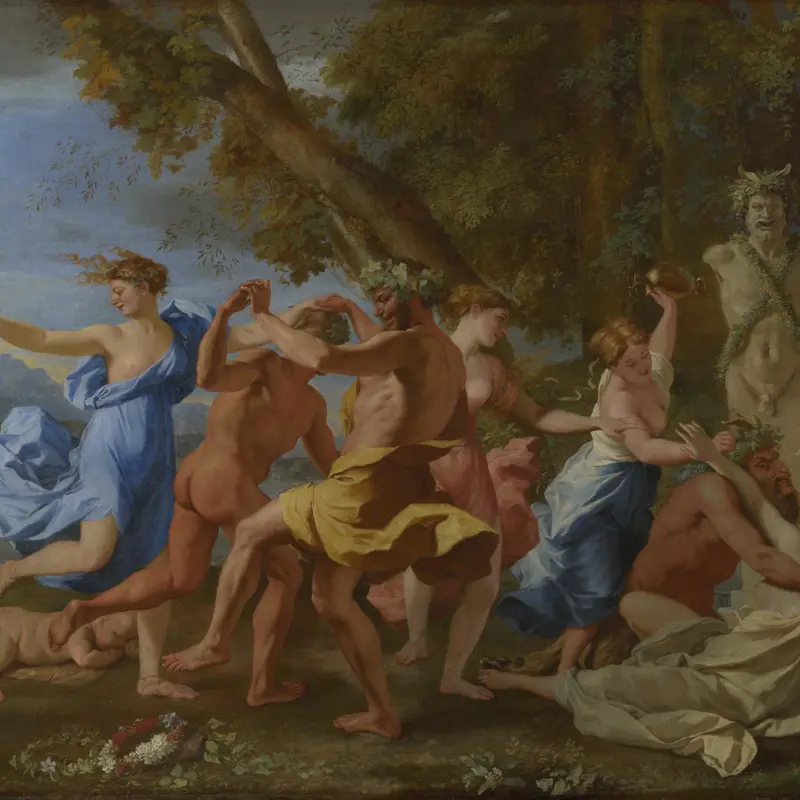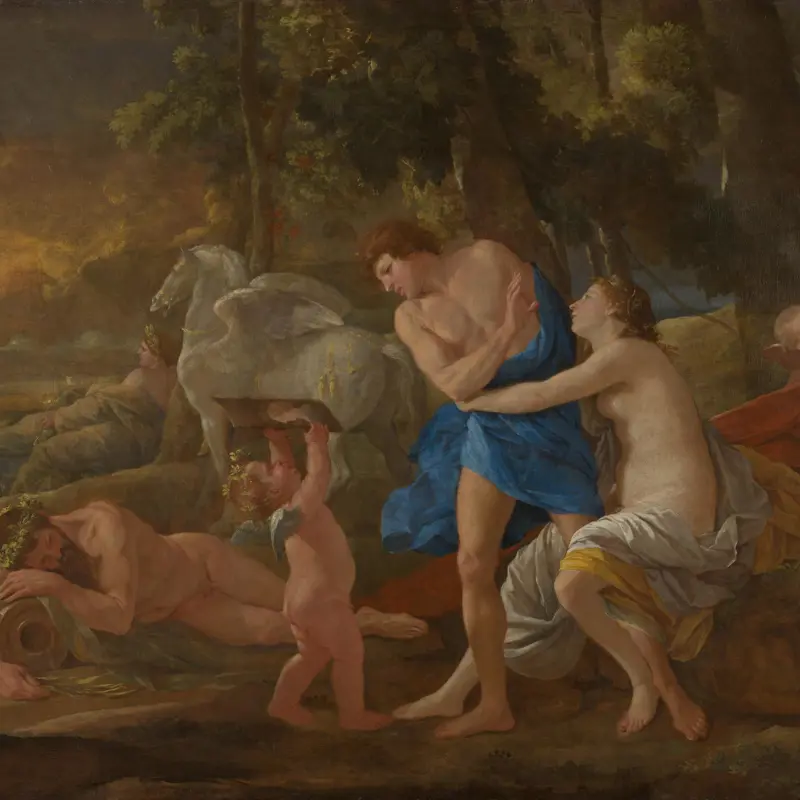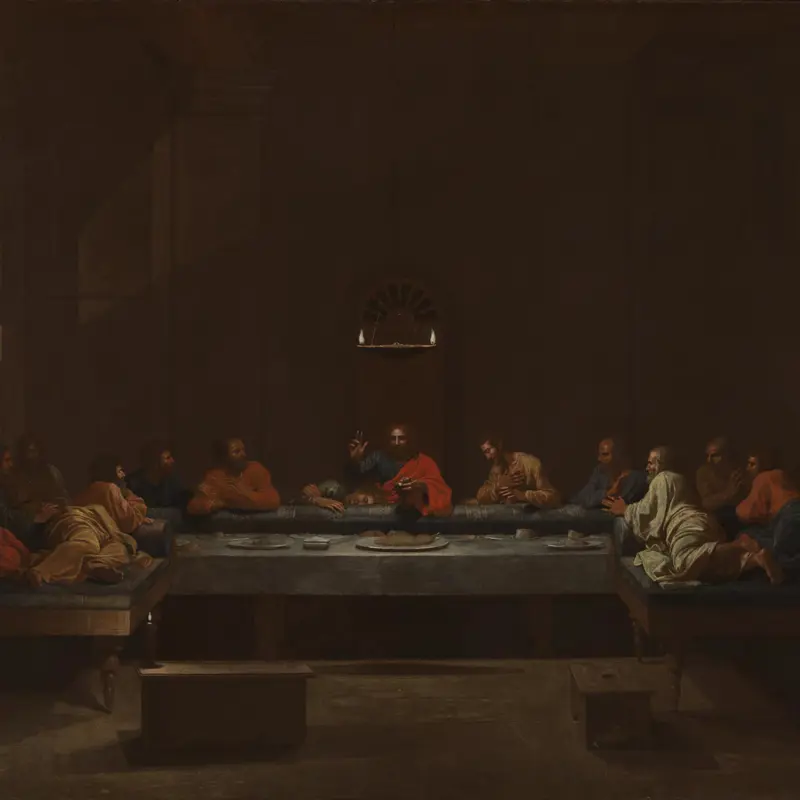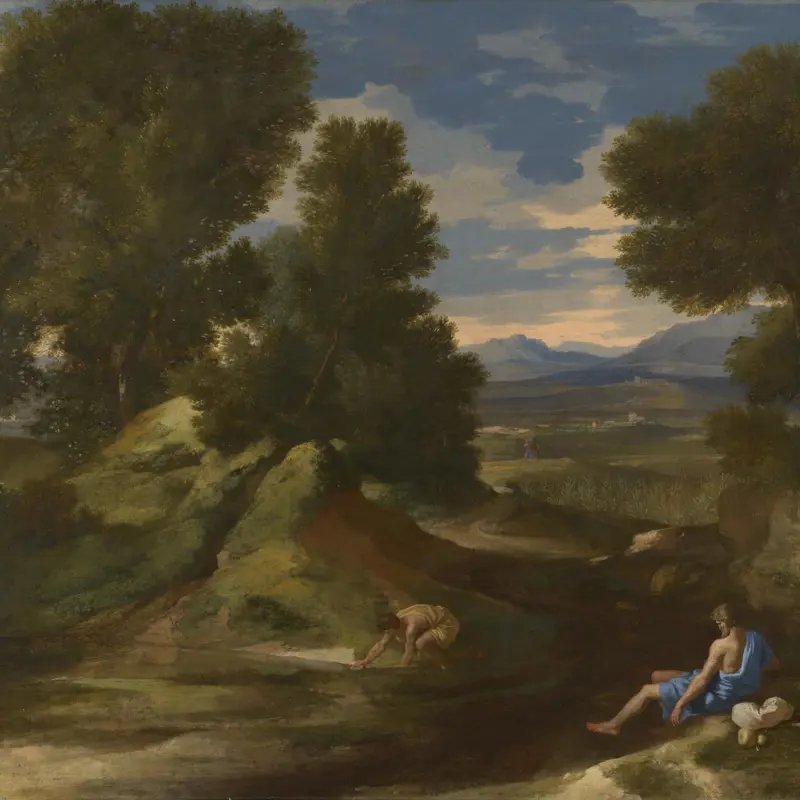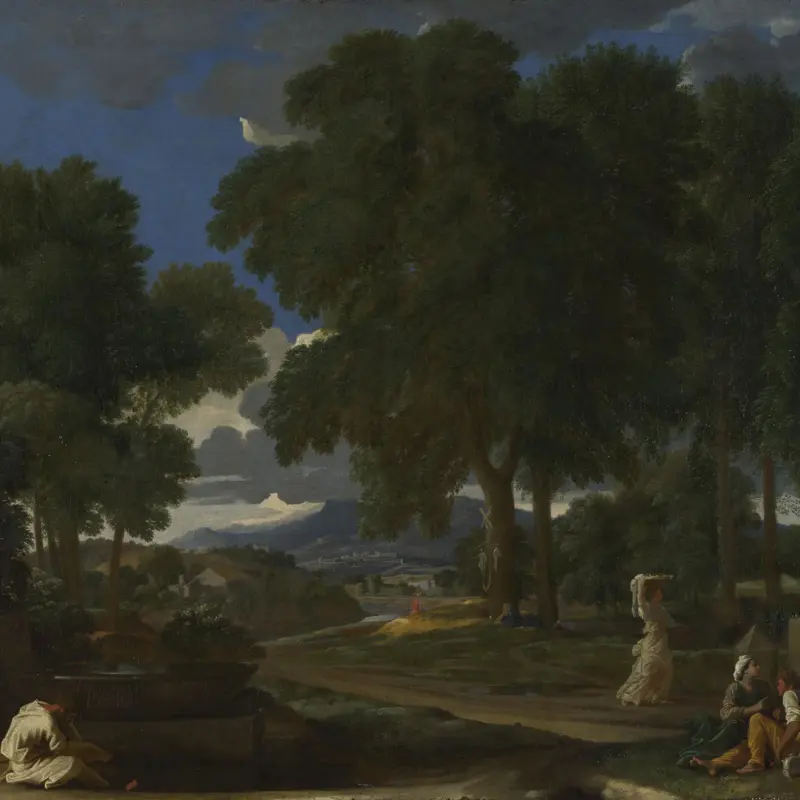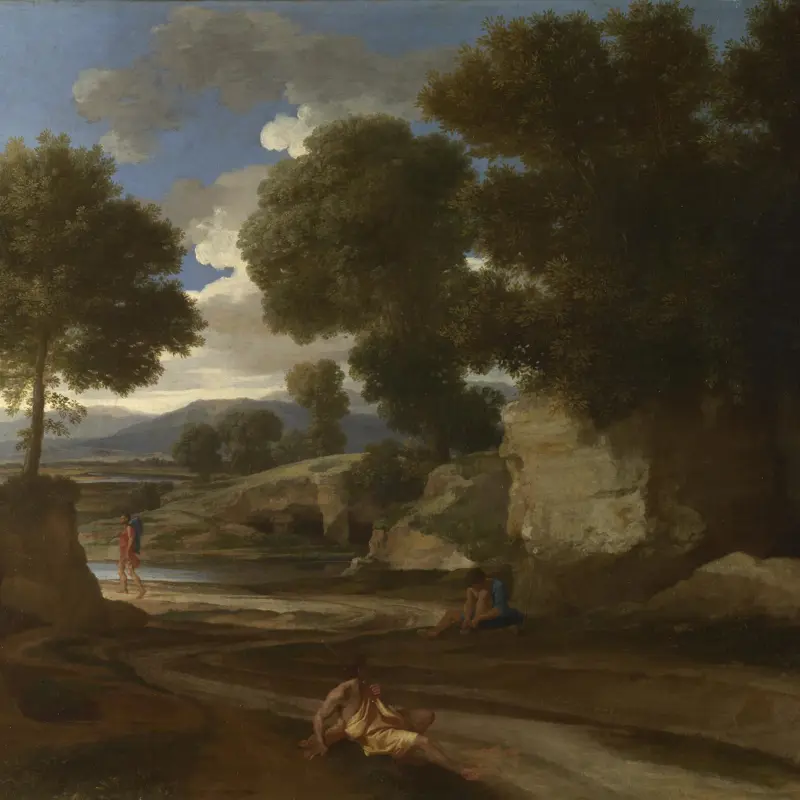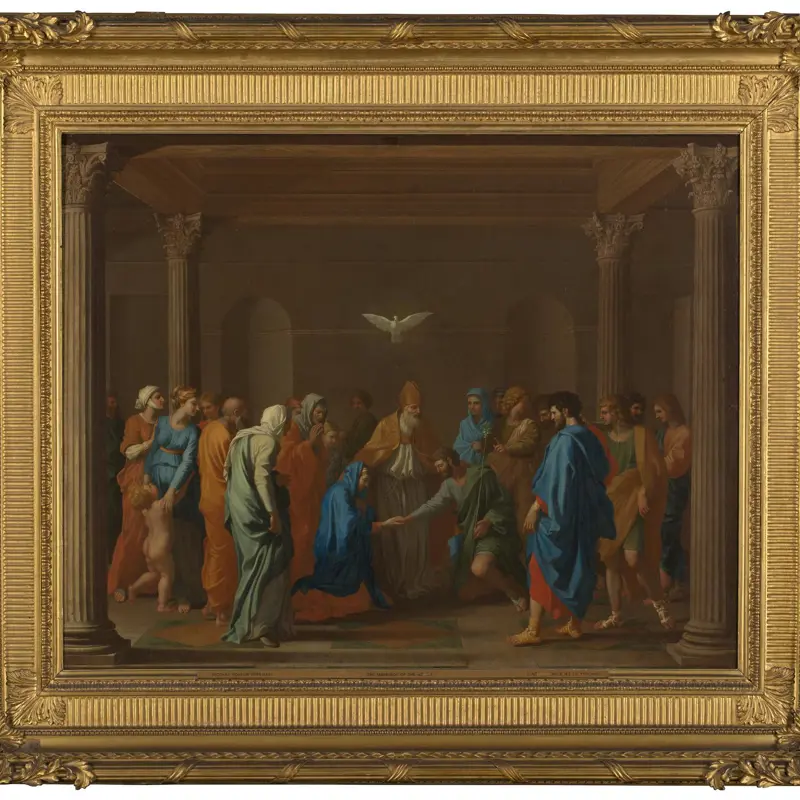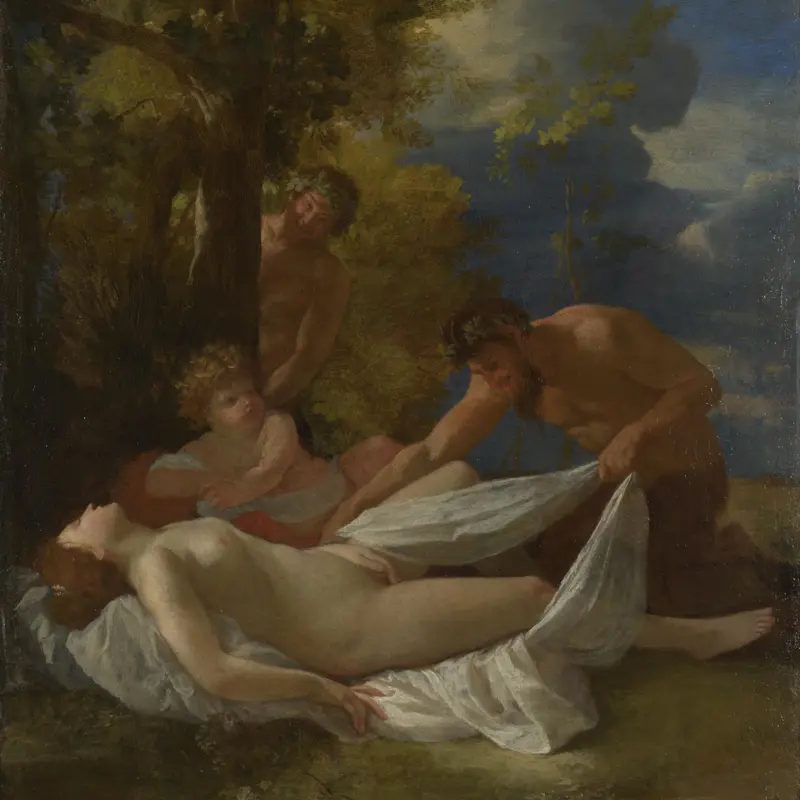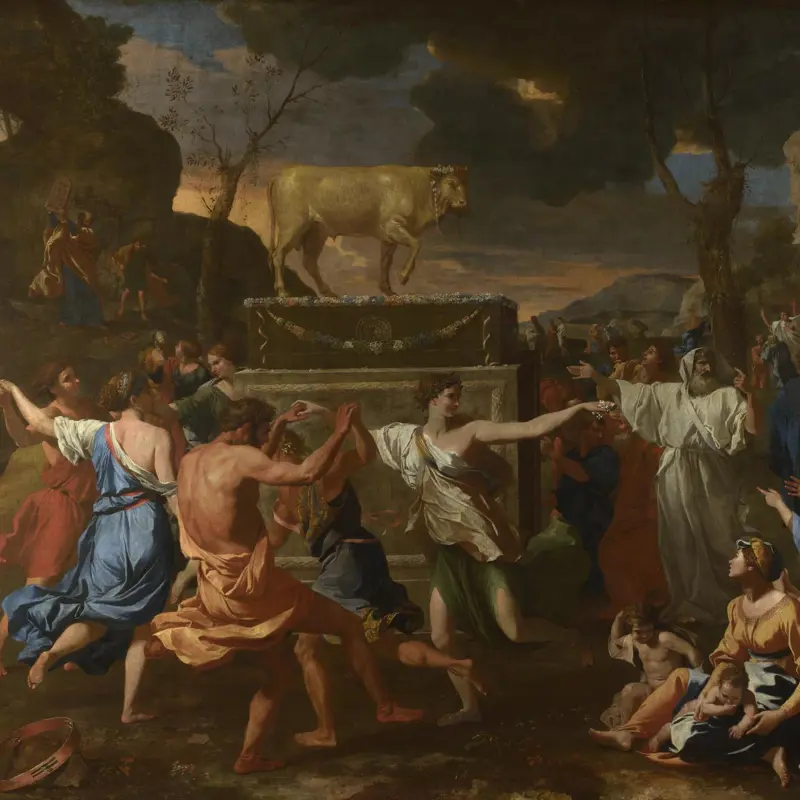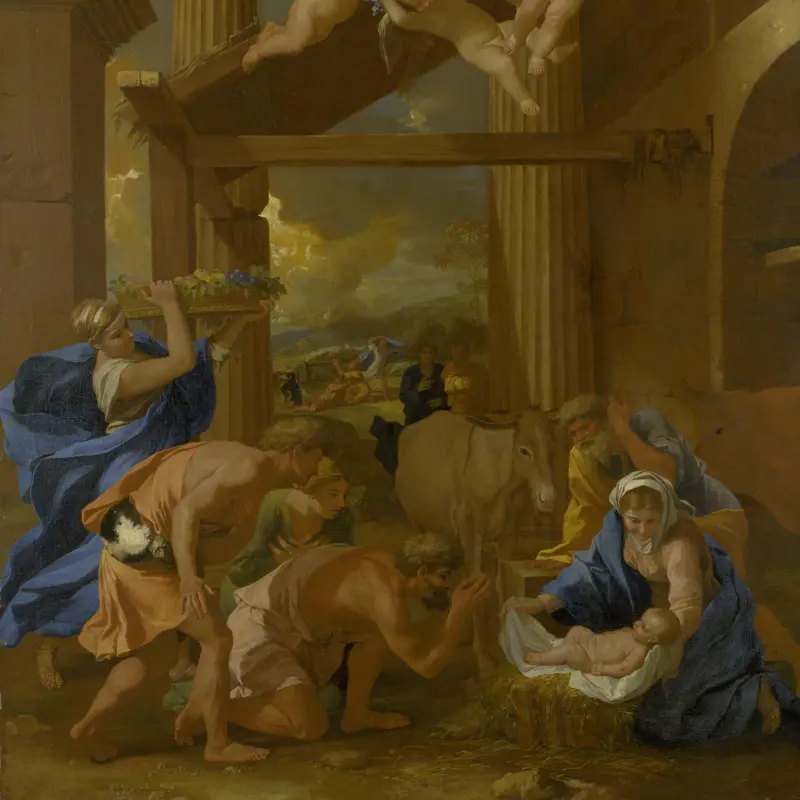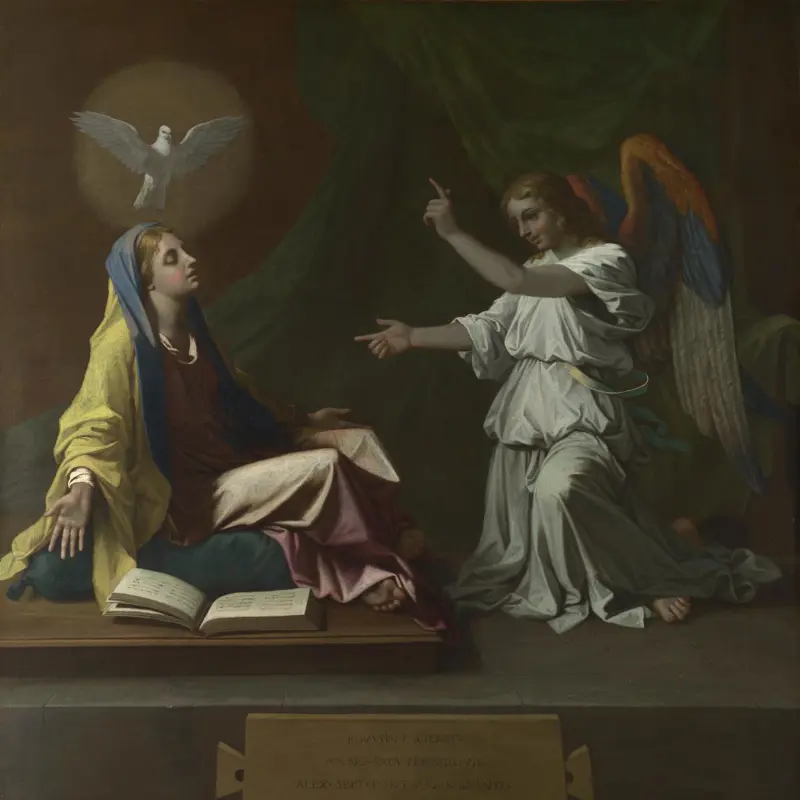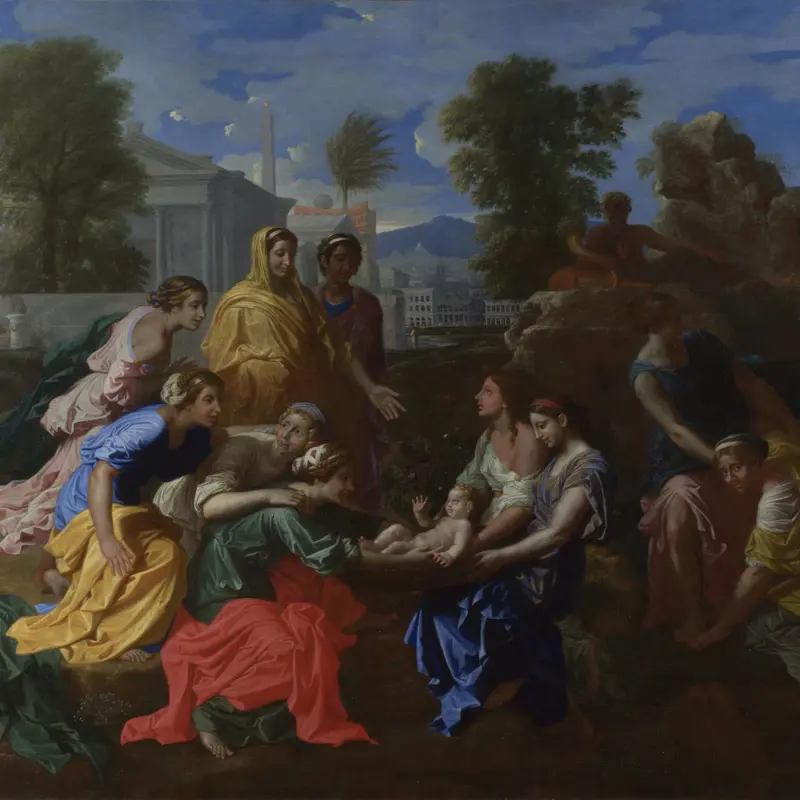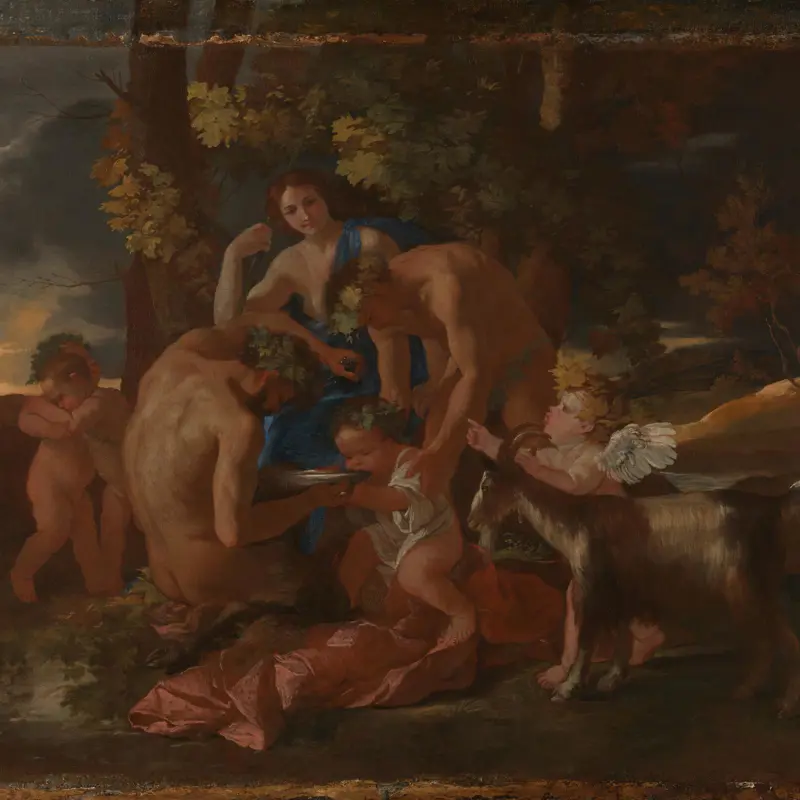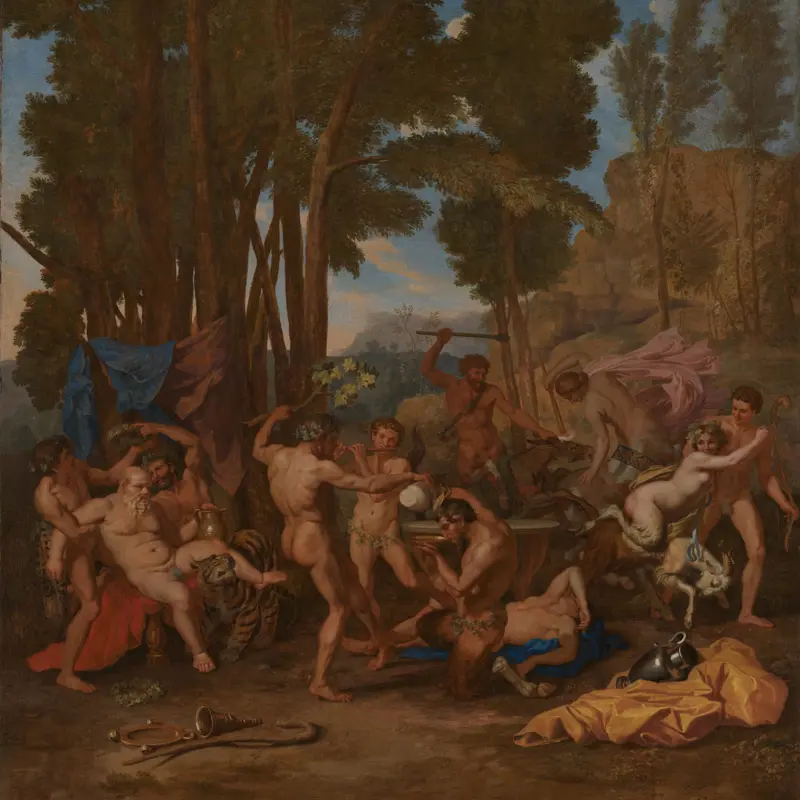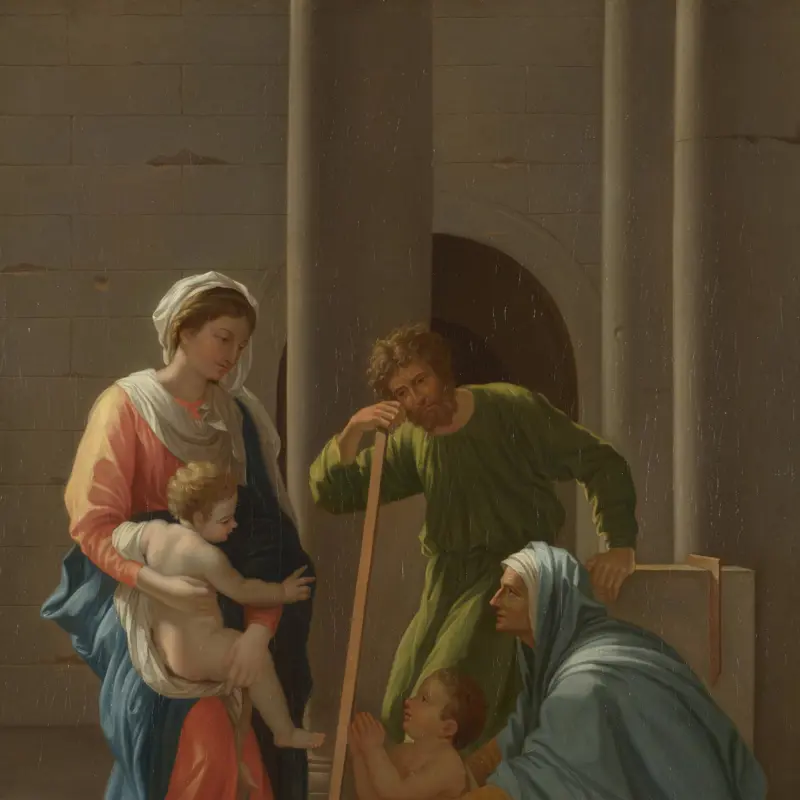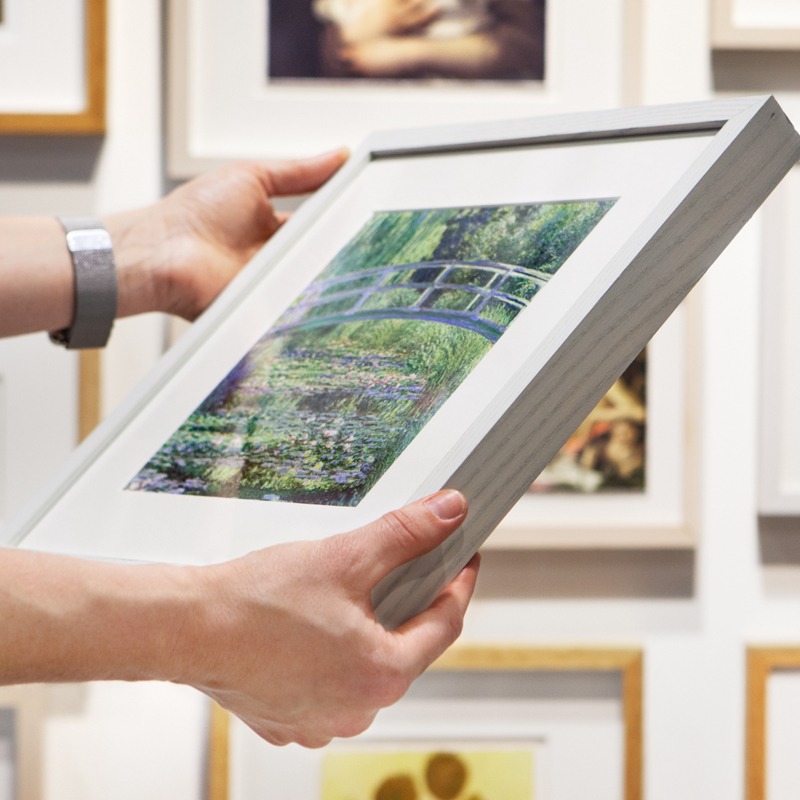Nicolas Poussin, 'The Triumph of Pan', 1636
About the work
Overview
In this chaotic woodland party, men and women dance, drink, play music and behave badly. They gather around a statue of a red-faced satyr with horns, which may represent Pan, god of shepherds and herdsmen, or Priapus, god of gardens. Both deities are linked to the mischievous god of wine, Bacchus. Bacchanalian festivals were held in ancient Roman times to ensure a good harvest, and according to literary descriptions they involved lots of sex and alcohol. The goat, faun and the flower garlands we see here were part of the festivities.
These naughty partygoers look like actors on a stage: the musical instruments and masks in the foreground relate to these festivals' dramatic plays. The muscular figures and their flowing drapery convey Poussin’s interest in Classical sculpture. The warmth of this scene is conveyed by the dusky sky and colourful draperies, now faded although once vibrant.
Key facts
Details
- Full title
- The Triumph of Pan
- Artist
- Nicolas Poussin
- Artist dates
- 1594 - 1665
- Date made
- 1636
- Medium and support
- oil on canvas
- Dimensions
- 135.9 × 146 cm
- Acquisition credit
- Bought with contributions from the National Heritage Memorial Fund and the Art Fund, 1982
- Inventory number
- NG6477
- Location
- Room 29
- Collection
- Main Collection
- Previous owners
- Frame
- 19th-century English Frame
Provenance
Additional information
Text extracted from the ‘Provenance’ section of the catalogue entry in Humphrey Wine, ‘National Gallery Catalogues: The Seventeenth Century French Paintings’, London 2001; for further information, see the full catalogue entry.
Exhibition history
-
2008Picasso et les MaîtresGaleries Nationales du Grand Palais8 October 2008 - 2 February 2009
-
2011Richelieu à RichelieuMusée des Beaux-Arts (Tours)12 March 2011 - 13 June 2011
-
2011Twombly and Poussin: Arcadian PaintersDulwich Picture Gallery29 June 2011 - 25 September 2011
-
2019The National Gallery Masterpiece Tour 2019Victoria Art Gallery (Bath)11 April 2019 - 7 July 2019York Art Gallery12 July 2019 - 22 September 2019Auckland Castle (The Church Commissioners)5 October 2019 - 5 January 2020
-
2021The Director's Choice: Lizards, Fancy Feathered Hats and TrickeryThe National Gallery (London)5 May 2021 - 9999
-
2021Poussin and the DanceThe National Gallery (London)9 October 2021 - 3 January 2022J. Paul Getty Museum (Los Angeles)15 February 2022 - 8 May 2022
Bibliography
-
1653D. de Saint-Sorlin, Les promenades de Richelieu ou Les vertus, Paris 1653
-
1672G.P. Bellori, Le vite de'pittori, Rome 1672
-
1725A. Félibien, Entretiens sur les vies et sur les ouvrages des plus excellens peintres, Trévoux 1725
-
1824W. Buchanan, Memoirs of Painting: With a Chronological History of the Importation of Pictures by the Great Masters into England Since the French Revolution, London 1824
-
1829
J. Smith, A Catalogue Raisonné of the Works of the Most Eminent Dutch, Flemish, and French Painters: In Which is Included a Short Biographical Notice of the Artists, with a Copious Description of Their Principal Pictures […], 9 vols, London 1829-1842
-
1854G.F. Waagen, Treasures of Art in Great Britain: Being and Account of the Chief Collections of Paintings, Drawings, Sculptures, Illuminated Mss. […], vol. 2, trans. E. Eastlake, London 1854
-
1907J. Reynolds, The Discourses of Sir Joshua Reynolds, Oxford 1907
-
1914O. Grautoff, Nicolas Poussin: Sein Werk und sein Leben, Munich 1914
-
1937L. Batiffol, Autour de richelieu, Paris 1937
-
1948P. Jamot, Connaissance de Poussin, Paris 1948
-
1950F.M. Godfrey, 'Baccanale e giardino d'amore', The Connoisseur, CXXVI, 1950
-
1966A. Blunt, The Paintings of Nicolas Poussin: A Critical Catalogue, London 1966
-
1979A. Blunt, The Drawings of Nicolas Poussin, New Haven 1979
-
1980D. Wild, Nicolas Poussin: Band I, Leben, Werk, Exkurse, Band II, Katalog der Werke, Zürich 1980
-
1981H. MaAndrew and H. Brigstocke, Poussin: Sacraments and Bacchanals: Paintings and Drawings of Sacred and Profane Themes by Nicolas Poussin 1594-1665, (exh. cat. National Gallery of Scotland, 16 October - 13 December 1981), Edinburgh 1981
-
1983H. Brigstocke, 'Poussin's Triumph of Pan and Rape of the Sabines: A Comparison of Two Masterpieces in the Classical Style', Art International, XXVI/4, 1983, pp. 12-5
-
1985National Gallery, The National Gallery Report: January 1982 - December 1984, London 1985
-
1990O. Bätschmann, Nicolas Poussin: Dialectics of Painting, London 1990
-
1990A. Mérot, Nicolas Poussin, London 1990
-
1992H. Wine and O. Koester, Fransk Guldalder: Poussin and Claude and French Painting of the Seventeenth Century, (exh. cat. Statens Museum for Kunst, 29 February - 3 May 1992), Copenhagen 1992
-
1993D.L. Sparti, 'Appunti sulle finanze di Nicolas Poussin', Storia dell'arte, LXXIX, 1993, pp. 341-50
-
1994J. Thuillier, Nicolas Poussin, Paris 1994
-
1994R. Verdi and P. Rosenberg, Nicolas Poussin, 1594-1665 (exh. cat. Galeries Nationales du Grand Palais, 27 September 1994 - 2 January 1995; Royal Academy of Arts, 19 January - 9 April 1995), Paris 1994
-
1995M. Bull, 'Poussin's Bacchanals for Cardinal Richelieu', The Burlington Magazine, CXXXVII/1102, 1995, pp. 5-15
-
1995R. White and J. Pilc, 'Analyses of Paint Media', National Gallery Technical Bulletin, XVI, 1995, pp. 85-95
-
1995H. Wine, 'Instruction and Delight: The Poussin Exhibitions at the Grand Palais, Paris and the Royal Academy', Apollo, CXLI/398, 1995, pp. 50-3
-
1996H. Brigstocke, 'Variantes, copies et imitations. Quelques réflexions sur les méthodes de travail de Poussin', in Nicolas Poussin (1594-1665): Actes du colloque organisée au musée du Louvre…1994, Paris 1996
-
1998R. Delfine, Études iconographique des Bacchanales Richelieu de Nicolas Poussin, Paris 1998
-
1998H. Keazor, Poussins Parerga. Quellen, Entwicklung und Bedeutung der Kleinkompositionen in den Gemiilden Nicolas Poussins, Regensburg 1998
-
1999E. Cropper, 'Conception and Deception: Poussin's Mirrors', Cleveland Studies in the History of Art, IV, 1999, pp. 76-95
-
2001
C. Baker and T. Henry, The National Gallery: Complete Illustrated Catalogue, London 2001
-
2001H. Wine, National Gallery Catalogues: The Seventeenth Century French Paintings, London 2001
-
2002T.P. Olson, Poussin and France: Painting, Humanism and the Politics of Style, London 2002
-
2002H.T. Goldfarb et al., Richelieu: Art and Power (exh. cat. Montreal Museum of Fine Arts, 18 September 2002 - 5 January 2003; Wallraf-Richartz-Museum, 31 January - 20 April 2003), Montreal 2002
-
2003C. Pace, 'Collecting French Seventeenth-Century Paintings for the Nation', Art History, XXVI/2, 2003, pp. 281-315
-
2004M. Clayton, Holbein to Hockney: Drawings from the Royal Collection, London 2004
-
2006J. Unglaub, Poussin and the Poetics of Painting: Pictorial Narrative and the Legacy of Tasso, Cambridge 2006
-
2006D. Bastet, 'Étude iconographique des Bacchanales Richelieu de Nicolas Poussin', Studiolo, 4, 2006, pp. 167-86
Frame
This replica frame dates from the nineteenth century. It is crafted from oak and limewood. On the back edge of the frame is a French acanthus-leaf moulding. The corner cartouches are adorned with S-scrolls, leaves and curling stepped scrolls that surround a small central palmette. Between the cartouches, strapwork is fitted with gadroons, various C-scrolls, and motifs of leaves and flower tendrils, which spill over the back edge. Most notably, on the vertical side moulding, a carved sunflower (almost hidden from view) symbolises longevity and lasting happiness. The leaves also spread over the sanded flat and lead to the French acanthus-leaf sight moulding.
A skilled ‘répareur’ meticulously crafted veins on the leaves, cross-hatchings and linear backgrounds using various-sized iron tools.
The frame on Poussin’s The Triumph of Pan is a copy of the eighteenth-century frame on The Triumph of Bacchus (Nelson-Atkins Museum of Art, Kansas City).
About this record
If you know more about this work or have spotted an error, please contact us. Please note that exhibition histories are listed from 2009 onwards. Bibliographies may not be complete; more comprehensive information is available in the National Gallery Library.

